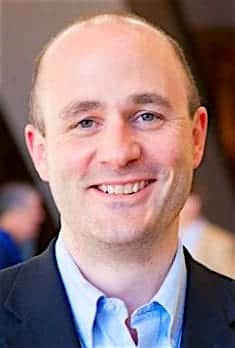A balancing between too much and too little communications structure at MIT
“If you have too much structure, you can inhibit innovation, and if you have too little structure, you can inhibit innovation.”
 John Letchford is working in a very technologically advanced and progressive environment, and that fact dictates how he manages things on a day-by-day basis. As the CIO at the Sloan School of Management at the Massachusetts Institute of Technology (known globally as MIT) he lives by the credo that every brilliant technological wonder they build today is going to be obsolete tomorrow. Therefore, he must be continually ready for the Next Great New Idea.
John Letchford is working in a very technologically advanced and progressive environment, and that fact dictates how he manages things on a day-by-day basis. As the CIO at the Sloan School of Management at the Massachusetts Institute of Technology (known globally as MIT) he lives by the credo that every brilliant technological wonder they build today is going to be obsolete tomorrow. Therefore, he must be continually ready for the Next Great New Idea.
To help foster that kind of innovation, he has to tread a fine line between promoting structure and promoting free-for-all creativity. As he puts it, “If you have too much structure, you can inhibit innovation, and if you have too little structure, you can inhibit innovation.”
He also has to be mindful of the fact that, when it comes to introducing new technology, he is dealing with two sets of people: 1.) Students who are digital natives and crave a rapid pace of change over the short time they are going to spend at MIT, and 2.) Faculty and staff who are in it for the long haul. This dynamic requires John and his team to keep open lines of communication with all the constituent groups to make sure everyone can achieve maximum productivity.
Interview Transcript:
Dr. Berger: John, it’s nice to be spending some time with you today. What’s really interesting when we look at the role of a chief information officer in higher education is that a lot of people don’t know the significance of what CIOs are doing to help not only integrate interesting and fun technology for students but also to serve as a gatekeeper. I mean that in a very positive way, so that we allow good things to come and push back on innovations that are not ready yet for implementation in the higher environment.
Tell me about what your day-to-day and how you take that role. Is that description fair or unfair?
 John Letchford: I think it’s very fair. I sit as the CIO for Sloan School of Management at MIT which is a very innovative place. I have to come into the office every morning with a mindset that anything we build is legacy the next morning and there are going to be very large numbers of creative ideas that come to the forefront in the discussions during the day.
John Letchford: I think it’s very fair. I sit as the CIO for Sloan School of Management at MIT which is a very innovative place. I have to come into the office every morning with a mindset that anything we build is legacy the next morning and there are going to be very large numbers of creative ideas that come to the forefront in the discussions during the day.
A very large proportion of my day is trying to work out where that sweet spot exists between having an appropriate level of streamlining/standardization and having innovation.
If you have too much structure, you can inhibit innovation and if you have too little structure, you can inhibit innovation. I think we’re always trying to work out the right way to go about doing that and, certainly, in terms of how we can manage data or information across the school in a way that really drives insight and value. We’re always looking at “What is the optimal way to architect things in terms of systems of records of engagement?” and how things can come together in a way that really works for everybody ─ the students, the faculty, the staff, the alumni, and so forth.
DB: I’m glad you brought that part at the end because I would imagine that one of the potential challenges for you in your role is assessing technology and saying, “Okay, this looks like it’s going to be very beneficial for our students at MIT.”
But we also have to understand the adoption rate from faculty. It can have two wildly different positions that we have to take and understand because the students are coming in as digital natives and that does not necessarily fit the description for faculty in all cases.
How do you go about marketing ─ if that’s the way to put it ─ a message to faculty knowing full well that from your perch, you see a very valuable technology that you have to create buy-in from the faculty and then, deploy to the students?
JL: You’re dealing with two very different constituent types. We have students who are going to be here for a very fixed period of time who want to have a very fast pace of change. Equally, we have a world-renowned faculty who has very clear priorities and we want to make sure that we’re not doing things which are unnecessarily disruptive; and have a very long-term focus.
The way we go about it is through communication and collaboration. We work with everybody in the staff as well as alumni in making sure that we’re engaging people of all different constituent types appropriately.
It is a bit of science, making sure requirements are understood; and some of it is a little bit of making sure that everyone has a voice. We want to make sure everyone’s voice is taken into account.
From a philosophy standpoint, as most people in MIT know, the better way to do it is iterating a little bit at a time. I find that to be quite effective ─ versus trying to do something big bang and explosive which has a higher risk of maybe not working for all the constituents.
We certainly have a very fast iteration-cycle approach of implementing things. When we’re introducing new platforms for collaboration or learning management or administrative processes – we will start off and work out what is the minimal thing we need to do here?
And then, iterate, iterate, and iterate. I mean, if we actually did track all the versions of the different solutions we’re putting in place, there are many, many, many iterations and we just keep putting things gently and it allows us to manage expectations, I think, quite effectively.
DB: John, are there inborn pressures on your end because you are at MIT, to present for review technology that has a certain level of brand awareness? Is there a challenge that we may not be thinking about just because of the well-known nature of MIT and its legacy, to your point earlier in the discussion?
 JL: From my perspective, yes. I think MIT is a truly wonderful and unique environment and culture. Although people tend to focus ─ at least, this is a personal reflection ─ on the technology within MIT, what MIT to me is an incredible ethos around innovation.
JL: From my perspective, yes. I think MIT is a truly wonderful and unique environment and culture. Although people tend to focus ─ at least, this is a personal reflection ─ on the technology within MIT, what MIT to me is an incredible ethos around innovation.
It creates an interesting challenge. In fact, what I’m trying to do here is create an environment that can continuously innovate and, more importantly, is responsive to ever-changing needs. I’m trying to look at things from that perspective rather than just from a purist technology perspective. When I say that things are “legacy,” they ought to be implemented. It is the mentality that we take here because the pace of change in terms of meeting the needs of faculty and students is so high that we’re always iterating.
Now, on the flipside, if you think about the 80/20 rule, we’re never spending time to get to a hundred percent because that isn’t the best value that can be delivered. It’s a culture that you have to get accountable with because if you have an expectation of coming here and building the most comprehensive, complete solution that will keep everyone happy, to me, that’s just not the way we do things here.
We’re iterating. We’re creative. We’re innovating. And the moment we’ve got something, we’re already looking to the next thing.
And so, there are two sides to that coin.
DB: I would imagine that, on the flip side, you probably have technologists and even small shops that would love to integrate and be part of the iterative process at MIT but just the sheer name alone makes it hard to say to them, “Look, we are open for business. We are looking for innovators regardless of the size of your company.”
Is that true? And how do you approach it so that you don’t miss innovation that may really have an opportunity to grow in a legacy fashion?
JL: I am always open to building partnerships and relationships. Without specifying names, there are certainly companies with whom we will work. An example, in the next couple of weeks, one vendor is working with some of my staff to basically do a two- or three-day hackathon to develop some code and web bots.
It’s great because we have very wonderful employees, students, staff and so forth; and from my perspective, the level of expertise is very high.
I’m trying to work out how I make sure the people here are always engaged having those relationships with vendors. And they get a lot out of it as well, obviously, dealing with high-caliber individuals.
I’d definitely like to build partnerships up and, frankly, look at every possible way to be creative as to how we deliver things. I’m sure, with many others schools of business or management we’re definitely trying to work at how we push further up the stack and really think about data and less about why it’s not pushing.
We really want to be pushing things up to the cloud and try to be as value-oriented as possible.
DB: One of the things that one of your professional colleagues in North Carolina talked about was the focus and the desire to understand identity management with faculty and students at the business school in Chapel Hill, North Carolina.
Is that something that you’re looking for or exploring in a world where we’re trying to really understand our students better beyond just that fixed term of them being on our physical campuses?

JL: Definitely! There are many different aspects to identity management ─ the key “how do you manage” authorization and authentication and single sign-on type of stuff. There’s managing the identities from a broad-relationship perspective.
Like most of the schools, we’re exploring, “What is the best way to create that comprehensive 360-degree view?”
The one thing that I’d say we’re definitely doing here ─ and I have to give a nod to my predecessor ─ is we’re taking a very platform-agnostic way of looking at our relationships with individuals, corporations or countries or whatever it might be ─ the whole relationship of the school.
We’re early in that process but one of the things that we’ve developed as a comprehensive central system of record around a lot of stuff that we do at the school. It becomes the system of record and then, we can plug in many of these systems of engagement. Making many of the companies and software and services that you’re probably very familiar with – the front end.
We kind of have a hub-and-spoke model and that, to me, feels like a very good long-term sustainable model for thinking about identities and how to manage all different attributes of information related to people as well as the more traditional or single sign-up types of stuff.
And then, there’s the whole cyber security aspect which we’re working on how to make sure that the information we have is protected and also being made available to those specific identities who should have access to it.
DB: John, let’s close with this. What is exciting to you that maybe we don’t know, as the general public? And the second part of this would be, from a technology perspective, are there lessons from what you are seeing down the pike in technology in higher ed that we can also apply to the K-12 environment? We’re starting to see more entities connecting the dots so that when we transfer students from high school to college and graduate school experiences, there is a level of continuity that impacts their learning, their engagement, and, hopefully, their success as well?
What are you seeing coming down the pike that is really interesting to you that we may not know about? And are there ways in which we can see them bearing fruit in K-12 as well?
JL: That’s a really good question. MIT has always done this but we’re trying to do more at the staff level within the Sloan School – is the existing culture of hacking. We had our first big multi-day staff hackathon last December and it was a huge success. We’re focusing on how we drive connectedness across the school.
Those are things which necessarily don’t have a strong technology bent at the beginning but they do, generally, at some point, lead to a technology integration – or solution-type implementation. Those are the things that I think are huge. Looking at K through 12, I do wonder how we can introduce more and more of these whole hackathon cultures further down into our youth.
I think I read a story that you’d written about how the students who are focused on being less consumers and more creators are going to be the most successful students in the future. That’s what we’re trying to do here. How do put the staff in the driving seat to actually go out and create great things? Certainly, that culture, I think, is just contagious whoever the constituent. Putting people in those positions, especially working at MIT – it’s the core of what we do. I think there’s huge potential.
I would also answer your question the other way around as well. What can K through 12 teach us? I’m sure there are plenty of things there as well.
 DB: That’s a point well taken. It’s going to benefit everybody when we’re looking at the student body. There are increasingly alternative ways to acquire post-high school success in education; and that can, then, impact a number of students who are coming to our campuses.
DB: That’s a point well taken. It’s going to benefit everybody when we’re looking at the student body. There are increasingly alternative ways to acquire post-high school success in education; and that can, then, impact a number of students who are coming to our campuses.
Obviously, it’s potentially a little bit different at a school at the level of MIT.
Let’s close with this. I can’t help but wonder just how exciting it is professionally and personally to be at MIT every day around that kind of mindshare and the quality of learning. That has to be exciting.
JL: It is. It’s also very humbling, let me tell you. I’ve done a number of senior-IT leadership roles. Coming here, it makes you realize how little you know when you’re surrounded by some incredible brain power.
It’s wonderful and humbling all at the same time.
DB: It’s been wonderful to catch up with you, John. Continued success!
JL: Thank you very much.
About John Letchford:
 John Letchford is currently the CIO for the MIT Sloan School of Management.
John Letchford is currently the CIO for the MIT Sloan School of Management.
Prior to that John had a one year appointment at Tufts University, assisting the University CIO with the transition towards an integrated IT operating and shared services delivery model as part of a larger university-wide effort to transform administrative processes and practices.
Before moving into Higher Education, John was CIO at the Commonwealth of Massachusetts. As CIO, John set strategic direction and led IT programs across executive government. In this role he served as the chair of the state’s IT governing body, the CIO Cabinet, and also served as a member of the State 911 Commission, Governor’s Health IT Council, and on the board of the Mass Broadband Institute. John was a director on the National Association of State CIOs (NASCIO) Executive Committee and in 2013 was named as one of Government Technology’s 2013 Top 25 Doers, Dreamers & Drivers in Public-Sector Innovation nationwide.
Prior to becoming State CIO, John was Deputy CIO, with overall responsibility for day to day service operations of the Information Technology Division and for overseeing the state’s information technology infrastructure consolidation program.
John was born in the UK and holds a bachelor’s degree in physics from the University of Exeter, and a master’s degree in information processing from the University of York.
This article was originally published in the Huffington Post .
AuthorDr. Berger is one of many industry education correspondents for the Mind Rocket Media Group, An educator and former school administrator. His video interview work and conversational podcasts have been featured in various media outlets. He often hosts education panel discussions and develops strategic content. As an academic Dr. Berger is a guest lecturer at Vanderbilt University’s Owen Graduate School of Management. A former assistant principal, he has been an adjunct undergraduate professor and developer of online college courses. He is a passionate Detroit sports fan who has also adopted Nashville sports teams as his own.
Contact the Mind Rocket Media Group if you are interested in an industry interview and a placement on EdCircuit.
Further Reading
- Boston Globe – Could an MIT team’s discovery one day restore the memories of Alzheimer’s patients?
- Quartz – MIT scientists created “living” jewelry that moves
- MIT News – MIT hosts STEM boot camp for veteran students
